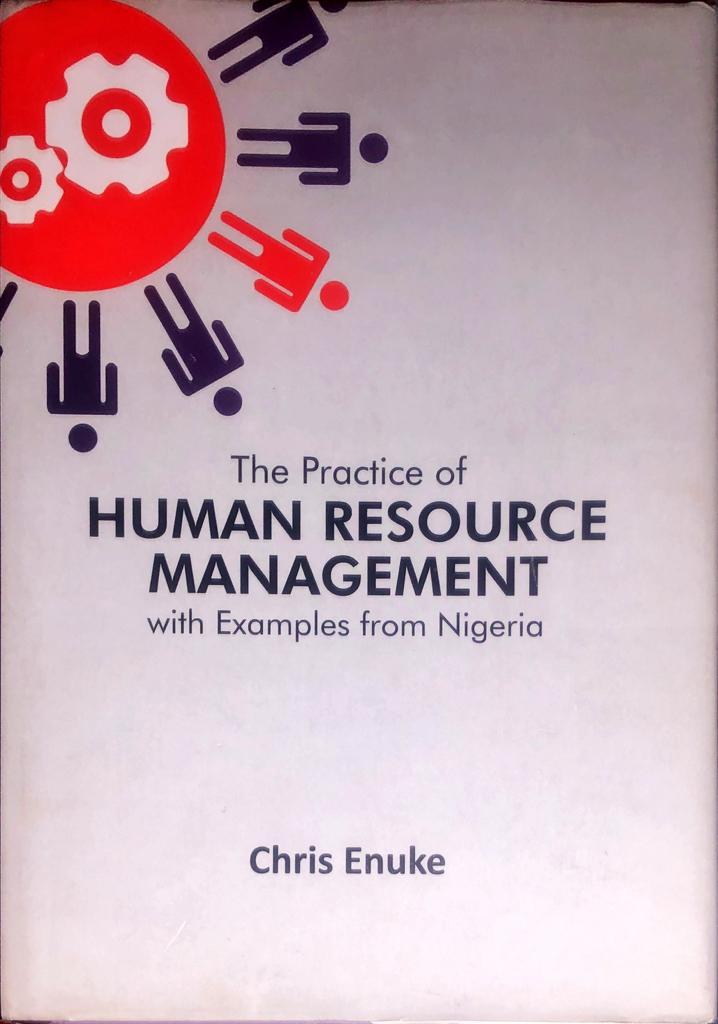Chris Enuke (2017), The Practice of Human Resource Management
with Examples from Nigeria. Ibadan: Feathers and Ink. ISBN: 978-978-53624-7. 670pages

With its positive approach to human resource management, this tome
belongs on the bookshelf of C-suite executives in MSMEs as well as the
more prominent and smaller players. It is a comprehensive handbook on
best practises in the management of the most critical asset of any
organisation. It draws on a quarter-century and counting of practice in a
global exemplar in managing the human capital, the behemoth Unilever,
with practical examples backing every subject.
While most firms agree that people are a crucial asset, the management
of that asset is often sub-optimal. Chris Enuke, a veteran of HRM in
Unilever and consultant to local and international organisations,
commences this dissertation with the case for clear-headed policies and
structures in talent management. “Of all the factors of production, it is
only men who can think and answer back. Because man can be
temperamental, exhibiting good and bad moods, we need specialists to
manage them. There should be a system in place to accomplish this;
there should be a Human Resource Policy, well-articulated, and in
writing and well-known to all key performers in the enterprise.”
People management is critical to organisational success. The Practice of
Human Resource Management with Examples from Nigeria makes the
case and systematically outlines the how and why of managing this vital
function. Practical examples in the best pedagogical traditions fill the
book. However, the reader will search in vain for management theories
and influences on HRM. Missing are classical management theory,
classical organisation theory, systems theory, the behavioural school,
TQM, excellence studies. There is no exegesis on Maslow’s Hierarchy of
Needs, Herzberg’s Motivator-Hygiene Theory, or McClelland’s three
needs theory.
The Practice of Human Resource Management with Examples from
Nigeria shows how to do things in talent management with sample
forms, tables, queries, letters, and policy documents. It then explains
why with an exposition of the theories and history.
It covers the employment cycle, from entry into employment, recruitment,
engagement, firing or retirement and exit from work. Chapter Four x-rays
“The legal basis of employment, and Nigerian Labour Laws”. It is a must-
read for owner-managers and those who sign the cheques or supervise
the entire workforce. It educates on the seven laws central to managing
employer-employee relations. They are the Labour Decree No 21 of
1974 and subsequent amendments to it; Factory’s Decree (as amended)
1987; and the Workmen’s Compensation Act 1987. Others include The
Trade Union Act No 31 of 1973, Wages Board and Industrial Councils
Act of 1973, Trade Disputes Decree No 7 of 1976 and Trade Disputes
(Essential Services) Decree No 23 of 1976 and subsequent
amendments.
The Practice of Human Resource Management with Examples from
Nigeria covers the core issues in HRM. They include training and
workforce development, performance appraisal principles and policies,
and employment maintenance issues such as welfare, medical, health,
uniforms, and protective clothing. Other areas include wages and salary
administration, job analysis and job evaluation, human resource records
and management of the human resource function.
What determines the structure of your organisation? Is it structured
along with the functions or the roles senior executives played in its
formation? Company organisation and structure, grievance and
discipline, industrial relations and relations with trade unions, collective
bargaining, strikes, and negotiations also feature.
Appendices containing practical examples and templates take up more
than half of the book. They ought to be incorporated into the relevant
departments as the term appendix may make unsuspecting readers fail
to pay attention to the rich trove of material herein. The absence of
theories of human resource management is a minus from the appeal of
the book. Well-grounded theories provide a sound handle for the
practices espoused here.
Many students will treasure this book. They include those seeking
chartered status with the CIPM, as well as in MBA and similar
programmes where HRM features. It is luxurious, practical, global, yet
local.

